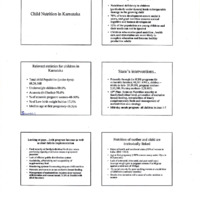Child Nutrition in Karnataka
Item
- Title
-
Child Nutrition in Karnataka
- extracted text
-
SDA-RF-CH-1B.5
Why this concern?
Child Nutrition in Karnataka
Relevant statistics for children in
Karnataka
• Total child Population (under 6yrs)68,26,168
• Underweight children-90.6%
• Anaemia (6-35mths)-70.6%
• % of anaemic pregnant women-48-50%
• % of Low birth weight babies-17.5%
• Median age at first pregnancy- 16.5yrs
• Nutritional deficiency in children
(particularly under 6years) leads to irreparable
damage in the growing child
• 75% of brain development occurs under 6
years, and good nutrition ensures normal
cognitive and human development
• 12% of the population are young children and
their needs can not be ignored
• Children who receive good nutrition , health
care and stimulation are more likely to
complete education and become healthy
productive adults
State’s interventions..
• Primarily through the ICDS programs for
vulnerable families( 40,301 AWCs, children6mths to 6yrs- 39,59,991, pregnant mothers2,15,000, Nursing mothers- 2,28,000)
• 10th Plan- focus on Nutrition security at
family/individual level, promotion of exclusive
breast feeding, introduction of timely
complementary feeds and management of
malnutrition as a strategy
• Mid-day meals program- all children in class 1-7
Sowv eg- $
Looking at gaps...both program lacunae as well
as short falls in implementation
Nutrition of mother and child are
intrinsically linked
• Food security at family/individual level also means
purchasing capacity,which also means employment
guarantee
• Lack of efficient public distribution system
• Availability, affordability and acceptability of
supplementary food.
• Monitoring systems for ensuring adequate child nutrition
• Maternity provisions to ensure exclusive breast feeding
• Management of malnutrition requires inter-sectoral
collaboration and commitment( ICDS & Health)with
all of the above
• Maternal health and nutritional status (36% of women in
India-BMI <18.5)
• Age at first pregnancy (>80% women marry under 18yrs in
N. Karnataka)
• Lack of ante-natal, intra-natal, and post natal care (
Average weight gain in pregnant women-5 to 6Kgs as
against a minimum of 10 Kgs)
• No social security for poor working women at crucial time
of childbirth (maternity benefits)
• Gender discrimination still a cause of under nutrition in
women
1
Other deficiencies..
General recommendations..
• Key service providers the ICDS and the Primary health
Centres have inadequate service delivery
• Lack of understanding by all stake holders, of the
importance of nutrition in young children
• AWW burdened with other responsibilities as frontline
worker for government
• No ownership of programs by communities, only seen as a
‘responsibility’ of government
• Local governance not involved
• Data not recorded efficiently and therefore not feeding
planning process
• Budgetary allocations inadequate to address all the issues
r
Specific recommendations..
•
As frontline workers AWWs & ANMs should work together -
•
To educate/monitor under weight pregnant women for adequate weight
gain
•
To promote and ensure exclusive breast feeding (also attend to breast
feeding problems)
•
To ensure that the lactating mother has maternity provisions( creche
services for the working mother, especially in un-organized sector)
•
To monitor infant feeding practices especially for pre-term/LBW baby
•
Early identification and treatment of infections/diseases
•
To provide special attention to malnourished children, in addition to
supplementary feeding
•
To ensure primary immunization especially for measles
•
Ensure supplementary feeding with locally available, acceptableand
affordable foods
•
Community health education with a focus on nutrition, child care and
effects of early marriage and pregnancy
•
Reach the excluded by universalisatkm of ICDS in every settlement
•
Programs should have a holistic vision and not a fragmented approach
to address issues
•
Improve service delivery by convergence between differentsectors,
both at policy and field level, especially ICDS and Health
•
Monitoringsystems that track progress, give feedback for improving
quality and assess requirements(human &financial) constantly
•
Specific tasks to frontline workers, to ensure achievable targets.
Ensure proper training and review training periodically.
•
All stakeholders to be aware of the programs and empowered to take
ownership for it
•
Local governance should be empowered, be one of the stake holders
and be accountable to indicators for well being of the child
•
There should be scope for innovation to meet challenges
•
Public -private partnershipshould be encouraged
•
Anaemia and how it affects their productivity,should be explained,
before giving iron and folic acid supplements. Iron supplements in
liquid /tablet form should be made available at AWC. De-worming
should precede.
•
Vitamin A deficiency should be addressed with supplements for
children and mothers especially in drought prone areas
•
Nutrition education has to be regular, with demonstration of low cost
nutritious food preparation
Specific recommendations..
•
De-worming for children should be done once in six months
•
Promote use of iodized salt by explainingthe effects of iodine
deficiency disorders (still births, spontaneous abortions, mental
retardation)
•
Establish ‘Bala Vikas Samithis’ to involve stake holders and for
accountability
•
Ensure adequate quantity of food (calories) to pre-primary children as
they bum up a lot ofenergy
•
Hamess the energies of adolescent girls for various interventions,as
they can become ‘change agents' in their communities
•
Document growth charts with diligence, as data recorded feeds
planning/budgetallocation and indicates progress made or regressed
In conclusion..
“Every child has only once chance to
develop normally. We cannot leave it
to chance alone”.
2
- Media
 SDA-RF-CH-1B.5.pdf
SDA-RF-CH-1B.5.pdf
Position: 6148 (1 views)
